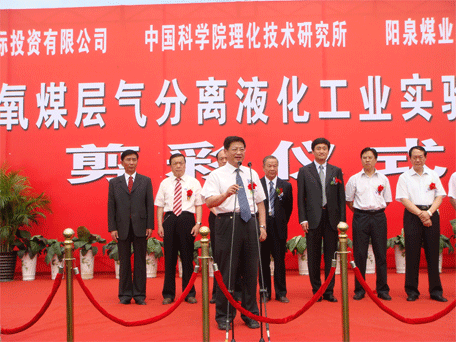|
|
| A Breakthrough of CBM Liquefaction and Separation In China |
 |
Text Size: A A A |
|

Exciting news comes from Yang Quan of Shan Xi province on 9 Aug, 2007. In a concerted effort of Technical Institute of Physics and Chemistry (TIPC, Chinese Academy of Sciences), Beijing Zancheng International Investment Co. Ltd and Yang Quan Coal Industry (Group) Co. Ltd., an industrial experimental equipment for liquefaction and separation of coal bed methane (CBM) with the capacity of 4300 cubic meters per day, has successfully been put into operation on the first time in the world. This great breakthrough indicates that industrial CBM liquefaction and separation will soon be realized in China and the main disservice of coal mine will be effectively controlled. The economical and environmental benefit is immeasurable. It will become a successful model of power saving, pollution reduction and effective resource utilization in China.
CBM is a flammable gas which is stored or adsorbed in the coal bed. Generally, more than 95% content of CBM is methane. CBM explosion is the most serious menace to the coal production safety. According to statistic, in China more than 46% coal mine has exceedingly high levels of CBM. On average, yearly fidelities of coal mine CBM explosion are in the amount of thousands. Nevertheless, CBM is also a valuable clean energy resource and an important industrial chemical. If it is not utilized effectively and vents to the environment, the destruction grade to the ozone layer is 21-23 times that of CO2.
The annual CBM output is more than natural gas output in China, but little has been put into industrial utilization. Most of the CBM vents to the atmosphere every year, thus not only serious air pollution is made but also valuable energy resource is wasted. Especially, the pumped CBM during coal production, because of air contamination, has less content of methane (about 50%, or 30%). The oxygen contained in the pumped CBM from the air contamination is dangerous and often cause explosion. It makes CBM processing and transportation become very difficult if not impossible, and this kind of CBM is usually vented out or used in small amount within local field.
TIPC is pioneering the development, design and application of gas refrigeration and liquefaction systems for over 50 years. Since 60s of last century, base on reviewing CBM resources in the main coal mines of China, analyzing the characteristics of air containing CBM, Research professor Yang Kejian and his collaborators at TIPC has took the lead in developing a cryogenic separation method to separate and liquefy methane from air containing CBM.
In 2003, cooperated with Beijing Zancheng International Investment Co., Ltd, the group at TIPC finished the design of a laboratory scale experimental system. In 2005, associate professor Zhang Wu and his team cooperated with Beijing Zancheng International Investment Co., Ltd and Jincheng Coal Mine Group began to develop two sets of industrial experimental systems. In May of 2007, Yang Quan Coal Industry (Group) Co., Ltd gave prodigious support to this project. The cryogenic separation method was adopted, which began to separate and liquefy methane from CBM and got successful result at the 5th mine of Yang Quan Coal Industry (Group) Co., Ltd. In 5 Aug, 2007, continuing flow of liquefied methane came out from the pipes, setting the record of the separation and liquefaction of CBM in industry in the world.
The success of this project received ardent responses from lots of coal mines in China; all expressed the urgent desire for cooperation. It is believed that, under the direction of national policy for power saving and pollution reduction, CBM separation and liquefaction will make a great contribution to coal mine safety and effective resource utilization in China.
 |
|
|

